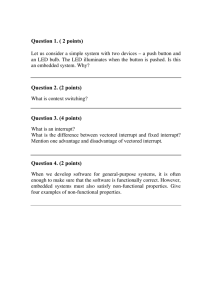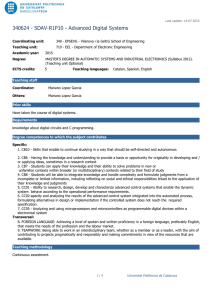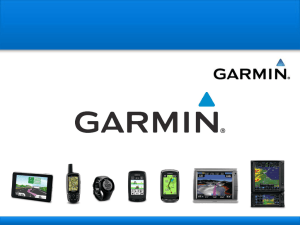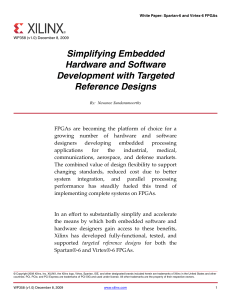Edged Detection Algorithm implemented in
advertisement
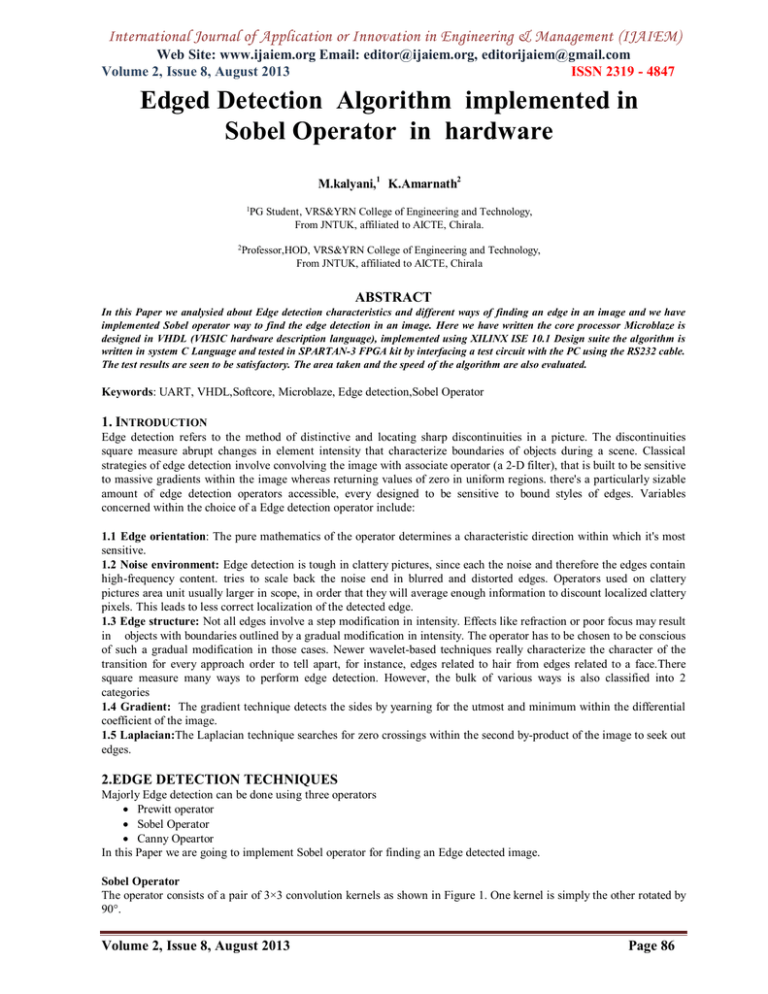
International Journal of Application or Innovation in Engineering & Management (IJAIEM)
Web Site: www.ijaiem.org Email: editor@ijaiem.org, editorijaiem@gmail.com
Volume 2, Issue 8, August 2013
ISSN 2319 - 4847
Edged Detection Algorithm implemented in
Sobel Operator in hardware
M.kalyani,1 K.Amarnath2
1
PG Student, VRS&YRN College of Engineering and Technology,
From JNTUK, affiliated to AICTE, Chirala.
2
Professor,HOD, VRS&YRN College of Engineering and Technology,
From JNTUK, affiliated to AICTE, Chirala
ABSTRACT
In this Paper we analysied about Edge detection characteristics and different ways of finding an edge in an image and we have
implemented Sobel operator way to find the edge detection in an image. Here we have written the core processor Microblaze is
designed in VHDL (VHSIC hardware description language), implemented using XILINX ISE 10.1 Design suite the algorithm is
written in system C Language and tested in SPARTAN-3 FPGA kit by interfacing a test circuit with the PC using the RS232 cable.
The test results are seen to be satisfactory. The area taken and the speed of the algorithm are also evaluated.
Keywords: UART, VHDL,Softcore, Microblaze, Edge detection,Sobel Operator
1. INTRODUCTION
Edge detection refers to the method of distinctive and locating sharp discontinuities in a picture. The discontinuities
square measure abrupt changes in element intensity that characterize boundaries of objects during a scene. Classical
strategies of edge detection involve convolving the image with associate operator (a 2-D filter), that is built to be sensitive
to massive gradients within the image whereas returning values of zero in uniform regions. there's a particularly sizable
amount of edge detection operators accessible, every designed to be sensitive to bound styles of edges. Variables
concerned within the choice of a Edge detection operator include:
1.1 Edge orientation: The pure mathematics of the operator determines a characteristic direction within which it's most
sensitive.
1.2 Noise environment: Edge detection is tough in clattery pictures, since each the noise and therefore the edges contain
high-frequency content. tries to scale back the noise end in blurred and distorted edges. Operators used on clattery
pictures area unit usually larger in scope, in order that they will average enough information to discount localized clattery
pixels. This leads to less correct localization of the detected edge.
1.3 Edge structure: Not all edges involve a step modification in intensity. Effects like refraction or poor focus may result
in objects with boundaries outlined by a gradual modification in intensity. The operator has to be chosen to be conscious
of such a gradual modification in those cases. Newer wavelet-based techniques really characterize the character of the
transition for every approach order to tell apart, for instance, edges related to hair from edges related to a face.There
square measure many ways to perform edge detection. However, the bulk of various ways is also classified into 2
categories
1.4 Gradient: The gradient technique detects the sides by yearning for the utmost and minimum within the differential
coefficient of the image.
1.5 Laplacian:The Laplacian technique searches for zero crossings within the second by-product of the image to seek out
edges.
2.EDGE DETECTION TECHNIQUES
Majorly Edge detection can be done using three operators
Prewitt operator
Sobel Operator
Canny Opeartor
In this Paper we are going to implement Sobel operator for finding an Edge detected image.
Sobel Operator
The operator consists of a pair of 3×3 convolution kernels as shown in Figure 1. One kernel is simply the other rotated by
90°.
Volume 2, Issue 8, August 2013
Page 86
International Journal of Application or Innovation in Engineering & Management (IJAIEM)
Web Site: www.ijaiem.org Email: editor@ijaiem.org, editorijaiem@gmail.com
Volume 2, Issue 8, August 2013
ISSN 2319 - 4847
These kernels are designed to respond maximally to edges running vertically and horizontally relative to the pixel grid,
one kernel for each of the two perpendicular orientations. The kernels can be applied separately to the input image, to
produce separate measurements of the gradient component in each orientation (call these Gx and Gy). These can then be
combined together to find the absolute magnitude of the gradient at each point and the orientation of that gradient. The
gradient magnitude is given by:
Typically, an approximate magnitude is computed using:
which is much faster to compute.
The angle of orientation of the edge (relative to the pixel grid) giving rise to the spatial gradient is given by:
3. BACKGROUND
The backbone of the design could be a single-issue, 3-stage pipeline with thirty two general registers (does not have any
address registers just like the Motorola68000 Processor), associate degree Arithmetic Logic Unit (ALU), a shift unit, and
2 levels of interrupt. This basic style will then be designed with additional advanced options to tailor to the precise wants
of the target embedded application such as: barrel shifter, divider, multiplier, single exactness floating-point unit (FPU),
instruction and knowledge caches, exception handling, rectify logic, quick Simplex Link (FSL) interfaces et al.
This flexibility permits the user to balance the specified performance of the target application against the logic space price
of the soft processor MicroBlaze additionally supports reset, interrupt, user exception, and break hardware exceptions. For
interrupts, MicroBlaze supports just one external interrupt supply (connecting to the Interrupt input port) (2). If multiple
interrupts square measure required, associate degree interrupt controller should be accustomed handle multiple interrupt
requests to MicroBlaze shown in figurel.
An interrupt controller is obtainable to be used with the Xilinx Embedded Development Kit (EDK) package tools. The
processor can solely react to interrupts if the Interrupt change (IE) bit within the Machine standing Register (MSR) is
about to one. On associate degree interrupt the instruction within the execution stage can complete, whereas the
instruction within the decrypt stage is replaced by a branch to the interrupt vector (address Ox 10). The interrupt name
and address (the computer related to the instruction within the decrypt stage at the time of the interrupt) is mechanically
loaded into general register. additionally, the processor additionally disables future interrupts by clearing the that is bit
within the MSR. The that is bit is mechanically set once more once execution the RTlD instruction. Writing package to
regulate the MicroBlaze processor should be drained C/C++ language. victimization C/C++ is that the m Development
Kit (EDK) package tools settle for. The EDK tools have inbuilt C/C++ compilers to get the required computer code for
the MicroBlaze processor.
Figure1: Microblaze Architecture Block Diagram
Volume 2, Issue 8, August 2013
Page 87
International Journal of Application or Innovation in Engineering & Management (IJAIEM)
Web Site: www.ijaiem.org Email: editor@ijaiem.org, editorijaiem@gmail.com
Volume 2, Issue 8, August 2013
ISSN 2319 - 4847
Due to the advancement within the fabrication technology and therefore the increase within the density of logic blocks on
FPGA, the utilization of FPGA isn't restricted any longer to debugging and prototyping digital electronic circuits.
attributable to the large correspondence doable on FPGA and therefore the increasing density of logic blocks, it's getting
used currently as a replacement to ASIC solutions in a very few applications wherever the time to plug is important and
conjointly entire embedded processor systems area unit enforced on these devices with soft core processors embedded
within the system. With the advancement of Field Programmable Gate Arrays (FPGAs), like addition of considerable
amounts of memory, a brand new trend has emerged within the style community to implement the microprocessors on the
FPGAs. These reasonably processors enforced on a reconfigurable material area unit referred to as soft-processors or soft
cores because the style of the microchip is on the market within the type of computer code bitstream ost popular
methodology by the general public and is that the format that the Xilinx Embedded which may be downloaded on FPGA
by the user. The users have the selection of choosing the resources on the processor and therefore the memory hierarchy.
Soft cores area unit designed to fulfill minimum performance specifications over a variety of technology implementations,
despite the fact that core performance varies across technologies. Soft cores area unit technology freelance and need solely
simulation and temporal order verification when synthesized to a target technology. This reduces {the style|the
planning|the look} cycle development time by a serious issue as compared to the event cycle for a tough core processor
and has the advantage of customizing the soft core design for a particular application. presently there area unit variety of
soppy cores out there within the markets that area unit developed by giants within the field of reconfigurable devices like
Xilinx. Xilinx has their own design named MicroBlaze during this arena and that they have conjointly ported the favored
PowerPC design to be used in embedded systems. These soft cores area unit out there within the type of synthesized
alpha-lipoprotein modules logic gate level netlists. System designers will plant these cores into their styles and optionally
add peripherals to the core.
4. EXPERIMENTAL SETUP
A. Xilinx Platform Studio
The Xilinx Platform Studio (XPS) is that the development setting or graphical user interface used for planning the
hardware portion of your embedded processor system. B. Embedded Development Kit Xilinx Embedded Development Kit
(EDK) is associate degree integrated software package tool suite for developing embedded systems with Xilinx
MicroBlaze and PowerPC CPUs. EDK includes a range of tools associate degreed applications to help the designer to
develop associate degree embedded system right from the hardware creation to final implementation of the system on an
FPGA. System style consists of the creation of the hardware and software package parts of the embedded processor system
and therefore the creation of a verification element is facultative. A typical embedded system style project involves:
hardware platform creation, hardware platform verification (simulation), software package platform creation, software
package application creation, and software package verification. BaseSystem Builder is that the wizard that's accustomed
mechanically generate a hardware platform in keeping with the user specifications that's defmed by the MHS
(Microprocessor Hardware Specification) file. The MHS file defines the system design, peripherals and embedded
processors]. The Platform Generation tool creates the hardware platform victimization the MHS file as input. The
software package platform is defmed by MSS (Microprocessor software package Specification) file that defines driver and
library customization parameters for peripherals, processor customization parameters, normal one hundred ten devices,
interrupt handler routines, and different software package connected routines. The MSS file is associate degree input to
the Library Generator tool for personalisation of drivers, libraries and interrupts handlers
.
Figure2: Embedded Development Kit Design Flow
Volume 2, Issue 8, August 2013
Page 88
International Journal of Application or Innovation in Engineering & Management (IJAIEM)
Web Site: www.ijaiem.org Email: editor@ijaiem.org, editorijaiem@gmail.com
Volume 2, Issue 8, August 2013
ISSN 2319 - 4847
The creation of the verification platform is nonmandatory and is predicated on the hardware platform. The MHS file is
taken as associate input by the Simgen tool to make simulation files for a particular machine. 3 kinds of simulation
models is generated by the Simgen tool: activity, structural and temporal order models. another helpful tools on the
market in EDK square measure Platform Studio that provides the user interface for making the MHS and MSS files.
produce / Import information science Wizard that permits the creation of the designer's own peripheral and import them
into EDK comes. Platform Generator customizes and generates the processor system within the style of hardware netlists.
Library Generator tool configures libraries, device drivers, file systems and interrupt handlers for embedded processor
system. Bitstream Initializer tool initializes the instruction memory of processors on the FPGA shown in figure2. antelope
Compiler tools square measure used for compilation and linking application executables for every processor within the
system [6]. There square measure 2 choices on the market for debugging the appliance created victimization EDK
namely: Xilinx silicon chip correct (XMD) for debugging the appliance software package employing a silicon chip correct
Module (MDM) within the embedded processor system, and software package program that invokes the software package
program cherish the compiler being employed for the processor. C. software package Development Kit Xilinx Platform
Studio software package Development Kit (SDK) is associate integrated development surroundings, complimentary to
XPS, that's used for C/C++ embedded software package application creation and verification. SDK is constructed on the
Eclipse opensource framework. Soft Development Kit (SDK) may be a suite of tools that permits you to style a software
package application for selected Soft
information science Cores within the Xilinx Embedded Development Kit (EDK).The software package application is
written during a "C or C++" then the entire embedded processor system for user application are going to be completed,
else correct & transfer the bit file into FPGA. Then FPGA behaves like processor enforced on that during a Xilinx Field
Programmable Gate Array (FPGA) device.
5.TABULATION RESULT
Fig3 : Synthesis report after Implementation
Fig4: Input Image read on Vb in PC
Volume 2, Issue 8, August 2013
Page 89
International Journal of Application or Innovation in Engineering & Management (IJAIEM)
Web Site: www.ijaiem.org Email: editor@ijaiem.org, editorijaiem@gmail.com
Volume 2, Issue 8, August 2013
ISSN 2319 - 4847
Fig5: Output Image read on Vb in PC
6. CONCLUSION
In this paper we evaluated Sobel operator edge detection on Image using Spartan 3 EDK kit using System C coding and
developed the architecture which shown as synthesis report as above which may useful for preparing the ASIC IC
development for Edge detection.
REFERENCES
[1] Umbaugh, Scott E (2010). Digital image processing and analysis : human and computer vision applications with
CVIPtools (2nd ed. ed.). Boca Raton, FL: CRC Press. ISBN 9-7814-3980-2052.
[2] H.G. Barrow and J.M. Tenenbaum (1981) "Interpreting line drawings as three-dimensional surfaces", Artificial
Intelligence, vol 17, issues 1-3, pages 75-116.
[3] a b Lindeberg,
Tony
(2001), "Edge
detection",
in
Hazewinkel,
Michiel, Encyclopedia
of
Mathematics, Springer, ISBN 978-1-55608-010-4
[4] a b c d T. Lindeberg (1998) "Edge detection and ridge detection with automatic scale selection", International Journal
of Computer Vision, 30, 2, pages 117--154.
[5] H. Neoh, A. Hazanchuk, “Adaptive Edge Detection for Real-TimeVideo Processing using FPGAs”, Global Signal
Processing (2004)
[6] SHIGERU.A, “Consistent Gradient Operators”, IEEE Transactionson Pattern Analysis and Machine Intelligence, 22
(3), 2000.
[7] Dong, Q., Song, C., Ben, C., Quan, L., “A fast subpixel edgedetection method using Sobel-Zernike moments
operator”, Image andVision Computing, Vol.23, pp.11-17, 2005.
[8] S. Mittal, S. Gupta, and S. Dasgupta, “System Generator: The State[9] Of-Art FPGA Design Tool For DSP Applications”, Third
[10] International Innovative Conference On Embedded Systems, MobileCommunication And Computing (ICEMC2
2008), August 11-14,2008, Global Education Center, Infosys.[9] T. A. Abbasi and M.U. Abbasi, “A proposed FPGA
basedarchitecture for sobel edge detection operator”, J. of Active and
Volume 2, Issue 8, August 2013
Page 90

